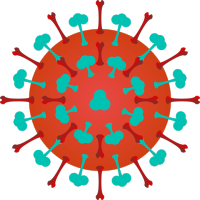| disease | Hip Joint Tuberculosis |
Hip joint subcutaneous nodes account for approximately 7.20% of all skeletal joint subcutaneous nodes, ranking second only to spinal subcutaneous nodes. They are more commonly seen in children and young adults, with a higher prevalence in males than in females. In 7-10% of cases, concurrent sacroiliac joint subcutaneous nodes or lower lumbar subcutaneous nodes may be observed.
bubble_chart Pathogenesis
Initial lesions are predominantly of the bone type, with the synovial type being less common. Bone-type lesions often originate in the acetabulum or femoral head, gradually expanding, penetrating the joint, and forming a total joint subcutaneous node. Synovial-type lesions can also spread and destroy joint cartilage, the femoral head, neck, and acetabulum, becoming a total joint subcutaneous node. Lesions often contain caseous material and cold abscesses, which can rupture into the inguinal region or greater trochanter, causing sinus formation and secondary infections. Progressive destruction of the femoral head and acetabulum, along with flexion and adduction spasms, can lead to pathological dislocation of the joint. After the lesion becomes quiescent, fibrous tissue proliferation can cause the joint to develop fibrous or bony ankylosis, often resulting in adduction and flexion deformities. The natural course of the disease is prolonged, inevitably leading to extensive destruction and deformity. It is essential to actively create conditions to resolve contradictions, eliminate unfavorable factors, transform the pathological process, and enable the patient to recover health and limb function as soon as possible.
bubble_chart Clinical Manifestations
(1) Pain The early symptom is pain in the hip and knee (radiating along the obturator nerve to the knee). Children often complain of knee pain, which should be prevented from being misdiagnosed as a knee joint disorder. Examination of the hip joint affected by seasonal disease shows limited movement and pain, which worsens with the progression of the disease and increases during activity.
(2) Muscle Spasm Muscle spasm caused by pain has a protective effect to prevent limb movement. Children often experience night crying. Prolonged spasm and disuse result in muscle atrophy, with the quadriceps muscle atrophy being particularly noticeable.
(3) Deformity Due to the result of muscle spasm, the hip joint has flexion and adduction contracture deformity, with a positive Thomas sign, and may lead to partial or complete dislocation of the hip joint, with relative shortening of the limb. In children, if the epiphysis is damaged, affecting growth length, the limb shortening is more pronounced. Due to pain, bone destruction, deformity, and limb shortening, the patient has varying degrees of limping.(4) Tenderness There is significant tenderness in the anterior and lateral parts of the hip joint. Although knee pain is felt, knee joint examination shows no abnormalities.
(5) Sinus Formation In the advanced stage, sinus formation is common, mostly at the greater trochanter or medial thigh, with joint infection. The patient may even be unable to walk.
bubble_chart Auxiliary Examination
X-ray examination reveals early localized osteoporosis of the femoral head and acetabulum. Later, due to cartilage destruction, the joint space narrows, and irregular bone destruction may occur, with the presence of sequestra or cavities. In severe cases, the femoral head and neck may be completely destroyed, but new bone formation is rare. Pathological dislocation may also be present.
The combination of disease history, systemic and local symptoms, erythrocyte sedimentation rate, imaging, and other factors should be analyzed. Attention should be paid to differentiating from suppurative arthritis and rheumatoid arthritis. Rheumatoid arthritis often involves multiple joints, and in advanced stages, joint stiffness may occur, but there are no bone lesions.
bubble_chart Treatment Measures
(1) For the treatment of subcutaneous node of the hip joint, the primary focus should be on systemic treatment to improve overall health and enhance the body's resistance.
(2) During the active phase of the subcutaneous node lesion and before and after surgery, anti-subcutaneous node medications should be applied.
(3) Traction can correct joint deformities caused by muscular rigidity. Continuous skin traction is used to partially or fully correct flexion contractures early on, and traction methods are employed to keep joint surfaces separated to prevent adhesions.
1. In cases of total joint subcutaneous node, due to extensive joint lesions, non-surgical therapies are unlikely to cure the condition, and joint stiffness and deformity are inevitable. Once systemic conditions improve, early surgical intervention should be pursued. This not only clears the lesion and shortens the course of the disease but also corrects deformities and fuses and fixes the joint in a functional position, facilitating early recovery and weight-bearing walking. Postoperatively, a hip spica cast is applied for approximately 3 months.
2. In synovial membrane type or early total joint subcutaneous node, especially in pediatric patients, if most of the joint surface is intact, care should be taken during the resection of the synovial membrane lesion or bone lesion to avoid intraoperative joint dislocation, which could affect femoral head circulation. Fusion surgery is not performed, and postoperative traction and anti-subcutaneous node medication continue. Early mobilization without weight-bearing can preserve partial or most of the joint's functional mobility.
3. In simple bone subcutaneous node, surgical removal of the subcutaneous node lesion is necessary to prevent the lesion from penetrating the joint and forming a joint subcutaneous node.
After the above surgeries, 1 gram of streptomycin is placed in the joint. If there is a sinus, 400,000 units of penicillin are also administered.







